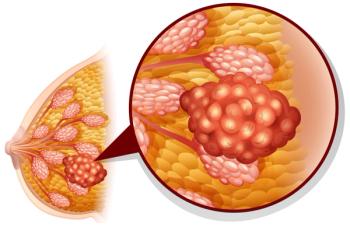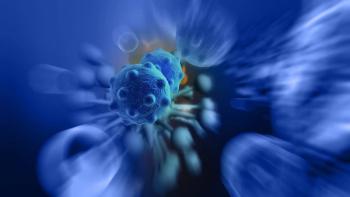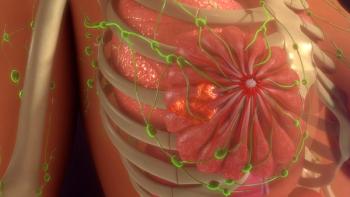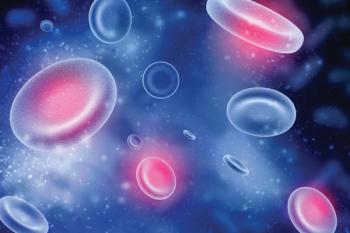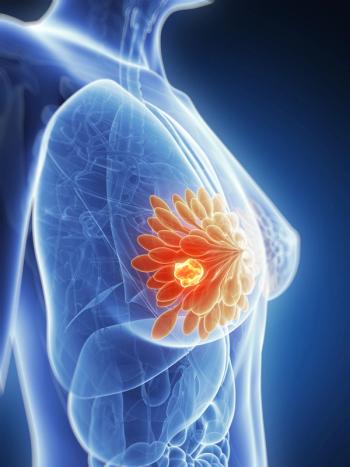
First-Line Nivolumab Combos Yield Improved OS Vs Chemo Alone in Esophageal Cancer
The CheckMate 648 trial found that using a combination of nivolumab and chemotherapy or nivolumab plus ipilimumab vs chemotherapy alone improved survival in advanced esophageal squamous-cell carcinoma.
Treatment with nivolumab (Opdivo) plus chemotherapy or nivolumab plus ipilimumab (Yervoy) in the first-line setting resulted in longer overall survival (OS) than chemotherapy alone for patients with advanced esophageal squamous-cell carcinoma, according to results from the phase 3 CheckMate 648 trial (NCT03143153).
After a 13-month minimum follow-up, the median OS was 15.4 months in the nivolumab plus chemotherapy group vs 9.1 months in the chemotherapy alone group (HR, 0.54; 99.5% CI, 0.37-0.80; P <.001) for patients with a PD-L1 expression of 1% or higher. Additionally, the median OS in the overall population was 13.2 months vs 10.7 months with each respective regimen (HR, 0.74; 99.1% CI, 0.58-0.96; P = .002). The median OS for those in the nivolumab plus ipilimumab group with a PD-L1 expression of 1% or higher was 13.7 months vs 9.1 months in the chemotherapy group (HR, 0.64; 98.6% CI, 0.46-0.90; P = .001), and the overall population had a median OS of 12.7 months vs 10.7 months, respectively (HR, 0.78; 98.2% CI, 0.62-0.98; P = .01).
A total of 970 patients were randomized 1:1:1 to receive nivolumab plus chemotherapy (n = 321), nivolumab plus ipilimumab (n = 325), or chemotherapy alone (n = 324). In the overall population, 70% of patients were from Asian countries and 49% had a PD-L1 expression of 1% or greater. The primary reason for treatment discontinuation was disease progression, including in 59% of patients in the nivolumab/chemotherapy arm, 54% of the nivolumab/ipilimumab arm, and 63% of the chemotherapy alone arm.
Patients received nivolumab intravenously at 240 mg every 2 weeks plus chemotherapy which consisted of a 4-week cycle of intravenous fluorouracil at 800 mg on days 1 through 5 and intravenous cisplatin at 80 mg on day 1; nivolumab intravenously at 3 mg per kilogram of body wight plus ipilimumab at 1 mg/kg; or chemotherapy alone.
Patients receiving nivolumab plus chemotherapy had a 46% decrease in the risk of death than with chemotherapy alone (HR, 0.54; 99.5% CI, 0.37-0.80; P <.001). At 12 months, 58% and 37% were alive, respectively.
The median progression-free survival (PFS) was determined to be 6.9 months (95% CI, 5.7-8.3) in the nivolumab/chemotherapy group and 4.4 months (95% CI, 2.9-5.8) in the chemotherapy alone group for those with a PD-L1 expression of 1% or greater (HR, 0.65; 98.5% CI, 0.46-0.92; P = .002). Additionally, the median PFS was 5.8 months (95% CI, 5.6-7.0) and 5.6 months (95% CI, 4.3-5.9) with the same respective treatment regimens in the overall population (HR, 0.81; 98.5% CI, 0.64-1.04; P = .04).
Patients had longer median duration of response (DOR) of 8.4 months in the nivolumab plus chemotherapy group compared with 5.7 months in the chemotherapy alone group among those with PD-L1 expression. In the overall population or and, respectively. Additionally, 16% of patients in the nivolumab/chemotherapy group had a complete response (CR) compared with 5% in the chemotherapy group for those with a PD-L1 expression of 1% or greater. The CR rates were 13% vs 6% in both respective treatment arms in the overall population.
Those who received nivolumab plus ipilimumab with a PD-L1 expression of 1% or greater achieved a median OS of 13.7 months (95% CI, 11.2-17.0) vs 9.1 months (95% CI, 7.7-10.0) in the chemotherapy group. The nivolumab plus ipilimumab regimen yielded a 36% reduced risk of death compared with chemotherapy (HR, 0.64; 98.6% CI, 0.46-0.90; P = .001).
At 12-months in the overall patient population, 57% and 37% of patients were alive in the nivolumab or chemotherapy groups, respectively. A median OS of 12.7 months (95% CI, 11.3-15.5) in the nivolumab group and 10.7 months (95% CI, 9.4-11.9) in the chemotherapy group was reported, translating to a 22% reduction in the risk of death in the nivolumab plus ipilimumab arm (HR, 0.78; 98.2% CI, 0.62-0.98; P = .01).
The median PFS by blinded independent central review for those with a PD-L1 expression of 1% or higher was 4.0 months (95% CI, 2.4-4.9) in the nivolumab group and 4.4 months (95% CI, 2.9-5.8) in the chemotherapy group. However, the difference between the groups did not meet the criteria for statistical significance (HR, 1.02; 98.5% CI, 0.73-1.43; P = .90).
The objective response by blinded independent review was 35% in those with a PD-L1 expression of 1% or higher who received nivolumab plus ipilimumab vs 20% in those receiving chemotherapy, with a (CR) of 18% vs 5%, respectively. Patients had a median DOR of 11.8 months in the nivolumab group and 5.7 months in the chemotherapy group. The objective response in the overall population was 28% in the nivolumab group and 27% in the chemotherapy group, and a CR of 11% vs 6%, respectively. The median DOR was 11.1 months in the nivolumab group and 7.1 months in the chemotherapy group.
In the nivolumab plus chemotherapy group, the duration of treatment was 5.7 months, as well as 2.8 months in the nivolumab plus ipilimumab group and and 3.4 months for chemotherapy alone.
Patients in the nivolumab plus chemotherapy group experienced more treatment-related adverse effects (TRAEs) that were grade 3 or 4, as well as any grade treatment-related serious AEs. Discontinuation due to TRAEs of any grade was higher in the nivolumab plus chemotherapy group compared with the other study groups. Treatment-related deaths occurred in 5 patients in the nivolumab plus chemotherapy cohort, 8 with nivolumab plus ipilimumab cohort, and 6 in chemotherapy alone cohort. The majority of TRAEs with potential immunologic causes were grade 1/2. Grade 3 or 4 TRAEs were reported in no more than 6% of patients.
Reference
Doki Y, Ajani JA, Kato K, et al. Nivolumab combination therapy in advanced esophageal squamous-cell carcinoma. N Engl J Med. 2022;386(5):449-462. doi:10.1056/NEJMoa2111380
Newsletter
Stay up to date on recent advances in the multidisciplinary approach to cancer.


